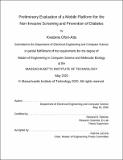| dc.contributor.advisor | Richard R. Fletcher. | en_US |
| dc.contributor.author | Ofori-Atta, Kwabena. | en_US |
| dc.contributor.other | Massachusetts Institute of Technology. Department of Electrical Engineering and Computer Science. | en_US |
| dc.coverage.spatial | n-us--- | en_US |
| dc.date.accessioned | 2020-09-15T21:59:18Z | |
| dc.date.available | 2020-09-15T21:59:18Z | |
| dc.date.copyright | 2020 | en_US |
| dc.date.issued | 2020 | en_US |
| dc.identifier.uri | https://hdl.handle.net/1721.1/127467 | |
| dc.description | Thesis: M. Eng. Computer Science and Molecular Biology, Massachusetts Institute of Technology, Department of Electrical Engineering and Computer Science, May, 2020 | en_US |
| dc.description | Cataloged from the official PDF of thesis. | en_US |
| dc.description | Includes bibliographical references (pages 99-105). | en_US |
| dc.description.abstract | Diabetes mellitus is a global health complication that has become increasingly prevalent. With millions of individuals developing diabetic symptoms, and a similar number of individuals dying to the disease, it is imperative that doctors and researchers develop tools that aid in diabetes treatment and prevention to diminish the load on various global healthcare systems. Despite advancements in treatment technologies, many of the current tools for diabetes screening are too expensive, too prone in causing infection, or not logistically practical for use in a majority of developing nations. This thesis presents a deep exploration of diabetes pathogenesis and etiology, as well as preliminary analyses of current and emerging non-invasive technologies for diabetes detection. Evaluation methods include an image quality analysis for patient image data, a diabetes questionnaire analysis, and the production of a semi-supervised auto encoder for patient labeling. | en_US |
| dc.description.abstract | The exploration of diabetes pathogenesis and etiology revealed that diabetes development can be broken down into six stages: Healthy (Stage 0), Compensation (Stage 1), Stable Adaptation (Stage 2), Unstable Early Decomposition (Stage 3), Stable Decomposition (Stage 4), and Severe Decomposition (Stage 5). With this biological understanding, this thesis reviews current and emerging non-invasive technologies for diabetes screening -- including infrared thermal imaging, skin fluorescence spectroscopy, retinal and iris imaging, nail fold capillaroscopy, pulse wave analysis, and breath analysis. The Mobile Technology Group, within the MIT D-Lab, has designed a mobile platform that integrates several of these non-invasive tests for diabetes -- including clinical questionnaires, thermal imaging, iris imaging, retina imaging, and finger photoplethysmography (PPG) -- | en_US |
| dc.description.abstract | that can be used to predict the severity of a patient's diabetic condition. These technologies are part of a clinical field study that is currently ongoing in Mumbai and Bangalore, India. This thesis presents two image data quality metrics -- blur and saturation detection -- that were developed and implemented to automatically assess the quality of image data collected in the field. The results of the analysis showed that blur detection via fast Fourier transform (FFT) and via Laplacian kernel are both effective methods, with the FFT method providing a tunable and more gradual measure of blur. The preliminary analyses of the India study data focused on the Diabetes Questionnaire. Since most study subjects were undergoing a form of treatment for diabetes, little correlation was found between patient diabetic indicators -- as measured by the Indian Diabetes Risk Score (IDRS) -- | en_US |
| dc.description.abstract | and patient random blood sugar (RBS) measurements. However, there is moderate correlation between patient RBS values and IDRS values among un-medicated patients, indicating that risk score can be used as a proxy for diabetes severity. Having used the IDRS values to create ground truths for patient labeling, a semi-supervised autoencoder was developed to enable scalable labeling of patient data. The autoencoder performed reasonably well, having a class-average area under the receiver operator characteristic (AUROC) of 0.845, and a class-average area under the precision-recall (AUPR) curve of 0.789. However, clustering methods using dimensionality reduced patient features (derived via autoencoder, PCA, and t-SNE) were less effective, yet the autoencoder still outperformed the controls. | en_US |
| dc.description.abstract | Since data collection is on-going, the predictive power of the autoencoder and its dimensionality reduction functionality is likely to improve with the addition of more patients and more measurements (i.e. retina, iris, and thermal image scores, PPG scores, and other questionnaire data). | en_US |
| dc.description.statementofresponsibility | by Kwabena Ofori-Atta. | en_US |
| dc.format.extent | 105 pages | en_US |
| dc.language.iso | eng | en_US |
| dc.publisher | Massachusetts Institute of Technology | en_US |
| dc.rights | MIT theses may be protected by copyright. Please reuse MIT thesis content according to the MIT Libraries Permissions Policy, which is available through the URL provided. | en_US |
| dc.rights.uri | http://dspace.mit.edu/handle/1721.1/7582 | en_US |
| dc.subject | Electrical Engineering and Computer Science. | en_US |
| dc.title | Preliminary evaluation of a mobile platform for the non-invasive screening and prevention of diabetes | en_US |
| dc.type | Thesis | en_US |
| dc.description.degree | M. Eng. Computer Science and Molecular Biology | en_US |
| dc.contributor.department | Massachusetts Institute of Technology. Department of Electrical Engineering and Computer Science | en_US |
| dc.identifier.oclc | 1192966974 | en_US |
| dc.description.collection | M.Eng.ComputerScienceandMolecularBiology Massachusetts Institute of Technology, Department of Electrical Engineering and Computer Science | en_US |
| dspace.imported | 2020-09-15T21:59:17Z | en_US |
| mit.thesis.degree | Master | en_US |
| mit.thesis.department | EECS | en_US |
